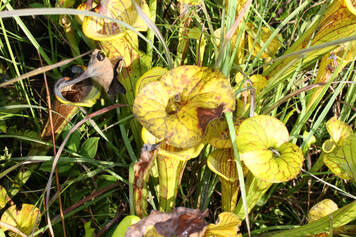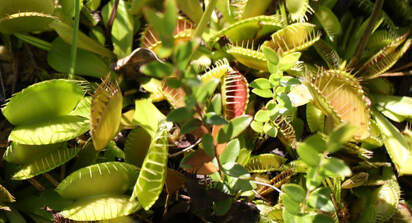
It is home to a number of threatened or endangered plants and wildlife.
My first trip was a field day sponsored by the Xerces Society’s Southeastern Bumble Bee Atlas (SEBBA) to survey the variety of bumble bees in the preserve. I’ve conducted a couple of surveys of my own and have only come across one species. However, that day we found four out of the five species living in this region. It may not sound interesting to you, but that’s a big deal, folks!
My second adventure concentrated on dragonflies, butterflies, and other winged wonders. My goodness, I never knew those guys came in so many sizes and colors. From inch-long damsel flies to the magnificent dragonflies patrolling the boggy landscape, I discovered there are countless creatures living around us, minding their own business while playing a significant role in the environment. That included a water moccasin we encountered (at a distance) while exploring one of the streams.

The Yellow pitcher plant (Sarracenia flava) grows in damp, moist terrain. It depends on insects for nutrients.
Insects are attracted to the pitcher-shaped hollow leaves that contain a pool of water. As the insect travels to the water, it encounters downward-pointing hairs that prevent the insect from exiting. The water pool contains insect-digesting enzymes that assist the plant in digesting its lunch.
It has been estimated that 97.5% of pitcher plant habitats have been destroyed in the southeastern United States. They have been threatened by ongoing development and habitat loss. I’m happy to report that LOBHP has a healthy population of the pitcher plants.

It grows in nutrient-poor soils along the coastal plain of the Carolinas. This plant gets most of its energy through photosynthesis but also receives some of its nutrients from digesting insects too. A small spider, ant, or other tiny insect crawling across a leaf brushes against tiny hairs that trigger the leaf to snap shut.
Horry County has the only remaining wild population of these rare plants in South Carolina, so they are protected from unwelcomed visitors and poachers. I feel privileged to have been trusted with their location.
Unfortunately, some bad guys try to make a few bucks by digging up and illegally selling these rare plants to unwary buyers. The US Fish and Wildlife Service offers tips on how to avoid purchasing a poached flytrap.
I can’t believe I’ve lived in this area since the 1980s and never knew the Lewis Ocean Bay Heritage Preserve existed. It is a fantastic place and well worth the two 102-mile round trips to visit. I will return there soon and tell you all about the treasures I find. In the meantime, if you are in the Myrtle Beach, SC area, drop by and see the wonders for yourself.
 RSS Feed
RSS Feed
